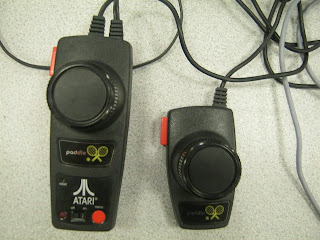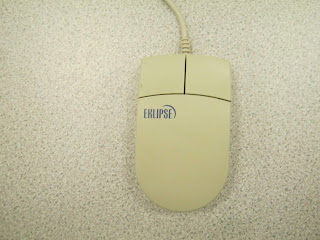Human Interface Devices
When we consider all developed computer and video games we must realise that each different game has a form of interface device to provide the player with some level of interactivity. Different controllers and pheribals can range vastly depending on the console or game; below you can actually see a range of different products available below.
Joysticks
With classic retro gaming the image that always pops into mind for me is the classic joystick, a revolutionising product that uses both analogue and digital functions in the product. The example given is a classic joystick from the original Atari product, it has the analogue stick that can move in multiple directions.
Pong Paddles
An extremely similar product to the joystick is the PONG controllers for the Atari Pong game. The paddle on the right is from the classic first generation of the Atari version of the game, however Atari also renewed the product for use on the television set with just the controller on the left containing all components. Both of the paddles use analogue and digital functions like the Joystick, a analogue dial to move the paddles in game and also a digital button for many uses such as hitting the ball in game.
Controllers
In later generations of video games a common form of interface device has emerged in the form of the controller. Nearly all major game developing companies have consoles using this form of device such as Nintendo, Microsoft, Sony with products such as Playstation, Xbox and Game Cube.
These devices can have a range of different functions to make the game more interactive. Multiple Digital buttons can be used in areas of the controller. Typically we see the use of a digital directional buttons usually for use in text based screens such as a main or options menus. Also commonly used is a selection of coloured buttons that represent actions in games whether it be in game on whilst browsing through menu screens. Some controllers express a small amount of 4 such as the Sony Playstation where as products from consoles as Microsoft Xbox and Nintendo Game cube can boast up to 6 different buttons.
I'm most of these consoles they retain a selection of triggers, buttons or paddles that express digital and analogue functions for a game: The Sony Playstation 2 uses digital buttons (R1, R2, L1, L2), The Nintendo Game Cube uses digital buttons. However if we look at a later generation we see some introduction of hybrid uses of the Analogue and Digital functions with the analogue triggers of the Xbox 360 or bumpers of the PS3 which are located at the top of the controllers. These increase interactivity with the player, these analogue functions can be used in driving games to successfully control speed. In first person shooter games these buttons can also be used as grenade throwing buttons where the length of time the grenade is cooked before throwing.
Although we can see uses of analogue functions in controllers much before the Xbox 360 and PS3, it was first introduced via the Playstation 1; Which used analogue toggles on the original duel shock controller, these are commonly used to control movement of a player and camera angles.
Light Guns
Other interface devices that have been created for consoles have had a range of different layout and designs for a range of different games and products. In the case of some shooter games such as Time Crisis we can see introduction of light guns, where a plastic gun pheribal will replace the controller and the players will have an opportunity to act out there favourite gun games. Some of these controllers also still possessed digital buttons at the handle of the gun to make browsing through menus much easier.
Portable Consoles
Despite the popularity of television displayed video game consoles there is always the side market of portable console where the equipment to run the game is embedded in the interface device: this means the console doesn't require to be constantly plugged into the electric mains.
When designing these products it is important to consider ergonomics and anthropometric related to the users. A console too bulky can be uncomfortable to use and thus make products redundant and unfun to play.
Most of these consoles use to same mixture of analogue and digital buttons that are used on a console controller. And also will use an inbuilt monitor and speakers for visual and audio.
Computer Mouse
One of the most popular interface devices used world wide is the computer mouse which is used on personal computers all over the globe whether it be for personal, work, educational use. Nearly every variation uses the default 3 methods for basic use and then sometimes additional buttons for extra methods. The basic 3 functions consist of two digital buttons (right and left clicker) and also an analogue mechanism used for navigating around the display. It used a small yet heavy ball in the center of the mouse with sensors and switches surrounding the ball, these detected when the ball was moving then would render the movement on screen using the cursor.
More modern day computer mouse's use lasers on the bottom of the mouse rather than the heavy ball method which made the mouse lighter and more manoeuvrable. Also modern day mice have be known to possess more than two digital buttons, there are devices that possess 4 buttons rather that 2 or even the options for a analogue turning wheel uses for scrolling.












